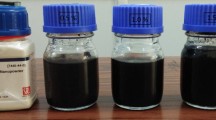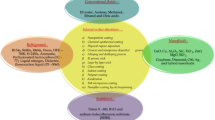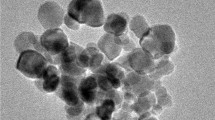Abstract
Growing technological developments to improve the thermal efficiency of heat pipes resulted in many innovative techniques. The use of nanofluids with superior thermophysical properties compared to conventional fluids is one such technique. However, the service life of nanofluid driven heat pipes is affected by agglomeration and stability issues, demanding an alternate solution. Boiling heat transfer rate of a heat pipe depends on the availability of working fluid at the evaporator, which is decided by the wick wettability and filling ratio. Wick wettability is improved with a hydrophilic coating using sol-gel dip coating process. Coating improves wick capillarity at the expense of wick permeability. Hence, an accurate balance of wick coating thickness and evaporator filling ratio are essential for the enhanced performance. The present work aims to demonstrate the benefits derived from optimal wick coating over these issues posed by nanofluids and to provide a better understanding on device level thermal performance. Thermal performance of coated mesh wick cylindrical heat pipe is experimentally studied for various coating thicknesses, evaporator filling ratios and inclinations. The existence of an optimum evaporator filling ratio for each coating thickness in boosting the limits of heat transfer is established. For the optimized values of inclination, coating thickness and evaporator filling ratio, a maximum reduction of 38.49% in thermal resistance and an improvement of 25% in thermal efficiency are obtained at 150 W heat input. The results from the repeatability test confirms coating stability.













Similar content being viewed by others
Abbreviations
- A :
-
Area (m2)
- C p :
-
Specific heat (J/kg K)
- I :
-
Current (A)
- k :
-
Thermal conductivity (W/m K)
- L :
-
Length (mm)
- m · :
-
Mass flow rate (kg/s)
- Q :
-
Input power (Heat supplied) (W)
- q :
-
Heat flux (W/m2)
- R :
-
Thermal resistance (K/W)
- T :
-
Temperature (K)
- ΔT:
-
Temperature difference (K)
- V :
-
Voltage (V)
- c:
-
Condenser
- cs:
-
Cross−section
- cv:
-
Condenser vapor
- cw:
-
Condenser wall
- e:
-
Evaporator
- Eq.:
-
Equivalent
- ev:
-
Evaporator vapor
- ew:
-
Evaporator wall
- o:
-
Overall
- th:
-
Thermal
- v:
-
Vapor
- w:
-
Water/wall
- CT:
-
Coated wick
- CT 1:
-
Coating thickness of sample 1
- DI:
-
Deionized
- UC:
-
Uncoated wick
- V:
-
Vapor
- W:
-
Wick
References
Mudawar I (2001) Assessment of high-heat-flux thermal management schemes. IEEE Trans Components Packag Technol 24:2122–2141
Xiao L, Li Y-R, Wu S-Y, Zhang Q-L (2012) Theoretical investigation on thermal performance of heat pipe flat plate solar collector with cross flow heat exchanger. Heat Mass Transf 48:1167–1176. https://doi.org/10.1007/s00231-012-0972-3
Nikolaenko YE, Baranyuk AV, Reva SA, Pis’mennyi EN, Dubrovka FF, Rohachov VA (2019) Improving air cooling efficiency of transmit/receive modules through using heat pipes. Thermal Sci Eng Prog 14:100418
Nadjahi C, Louahlia-Gualous H, Le Masson S (2019) Experimental study and analytical modeling of thermosyphon loop for cooling data center racks. Heat Mass Transf. https://doi.org/10.1007/s00231-019-02695-x
Asirvatham LG, Nimmagadda R, Wongwises S (2013) Heat transfer performance of screen mesh wick heat pipes using silver–water nanofluid. Int J Heat Mass Transf 60:201–209
Sadeghinezhad E, Mehrali M, Rosen MA, Akhiani AR, Latibari ST, Mehrali M, Metselaar HSC (2016) Experimental investigation of the effect of graphene nanofluids on heat pipe thermal performance. Appl Therm Eng 100:775–787. https://doi.org/10.1016/j.applthermaleng.2016.02.071
Venkatachalapathy S, Kumaresan G, Suresh S (2015) Performance analysis of cylindrical heat pipe using nanofluids – an experimental study. Int J Multiphase Flow 72:1881–1197. https://doi.org/10.1016/j.ijmultiphaseflow.2015.02.006
Putra N, Septiadi WN, Rahman H, Irwansyah R (2012) Thermal performance of screen mesh wick heat pipes with nanofluids. Exp Thermal Fluid Sci 40:10–17. https://doi.org/10.1016/j.expthermflusci.2012.01.007
Ghanbarpour M, Nikkam N, Khodabandeh R, Toprak MS, Muhammed M (2015) Thermal performance of screen mesh heat pipe with Al2O3 nanofluid. Exp Thermal Fluid Sci 66:213–220. https://doi.org/10.1016/j.expthermflusci.2015.03.024
Cacua K, Buitrago-Sierra R, Herrera B, Elizabeth P, Sohel Murshed SM (2019) Nanofluids’ stability effects on the thermal performance of heat pipes – a critical review. J Therm Anal Calorim 136:1597–1614. https://doi.org/10.1007/s10973-018-7787-5
Bhullar BS, Gangacharyulu D, Das SK (2017) Temporal deterioration in thermal performance of screen mesh wick straight heat pipe using surfactant free aqueous nanofluids. Heat Mass Transf 53:241–251. https://doi.org/10.1007/s00231-016-1785-6
Madhusree K, Dey TK (2013) Thermal performance of screen mesh wick heat pipes using water based copper nanofluids. Appl Therm Eng 50(1):763–770
Brusly Solomon A, Ramachandran K, Pillai BC (2012) Thermal performance of a heat pipe with nanoparticles coated wick. Appl Therm Eng 36:106–112
Tharayil T, Asirvatham LG, Rajesh S et al (2018) Effect of nanoparticle coating on the performance of a miniature loop heat pipe for electronics cooling applications. ASME J Heat Transf 140:2.9. https://doi.org/10.1115/1.4037541
Lee KL, Anderson WG, Tarau C (2018) Titanium-water heat pipe radiators for kilopower system cooling applications. In: International energy convers. Engineering conference; 2018 Jul 9–11; American Institute of Aeronautics and Astronautics, Cincinnati, Ohio; 2018:1–11. doi:https://doi.org/10.2514/6.2018-4581
Gupta NK, Tiwari AK, Ghosh SK (2018) Experimental study of thermal performance of nanofluid-filled and nanoparticles-coated mesh wick heat pipes. J Heat Transf 140(10):102403. https://doi.org/10.1115/1.4040146
Teng TP, Hsu HG, Mo HE, Chen CC (2010) Thermal efficiency of heat pipe with alumina Nanofluid. J Alloys Compd 504S:S380–S384. https://doi.org/10.1016/j.jallcom.2010.02.046
Naphon P, Assadamongkol P, Borirak T (2008) Experimental investigation of titanium nanofluids on the heat pipe thermal efficiency. Int Commun Heat Mass Transf 35:1316–1319
Manimaran R, Palaniradja K, Alagumurthi N (2012) Effect of filling ratio on thermal characteristics of wire-mesh heat pipe using copper oxide nanofluid. Front Heat Pipes (FHP) 3:023004. https://doi.org/10.5098/fhp.v3.2.3004
Jyothi Sankar PR, Venkatachalapathy S, Santhosh Kumar MC (2020) Effect of hydrophilic coating on mesh wicks used in heat pipes. Surf Eng 36(7):680–686. https://doi.org/10.1080/02670844.2019.1695370
Jyothi Sankar PR, Venkatachalapathy S, Asirvatham LG (2020) Thermal performance enhancement studies using graphite nanofluid for heat transfer applications. Heat Transf. https://doi.org/10.1002/htj.21758
Putra N, Septiadi WN (2017) Improvement of heat pipe performance through integration of a coral biomaterial wick structure into the heat pipe of a CPU cooling system. Heat Mass Transf 53:1163–1174. https://doi.org/10.1007/s00231-016-1890-6
Author information
Authors and Affiliations
Corresponding author
Ethics declarations
Conflict of interest
We don’t have conflict of interest with any individual or organization.
Additional information
Publisher’s note
Springer Nature remains neutral with regard to jurisdictional claims in published maps and institutional affiliations.
Rights and permissions
About this article
Cite this article
Sankar, P.R.J., Venkatachalapathy, S. & Asirvatham, L.G. Combined effects of filling ratio and wick surface coating on thermal performance of cylindrical heat pipes. Heat Mass Transfer 57, 1171–1182 (2021). https://doi.org/10.1007/s00231-021-03017-w
Received:
Accepted:
Published:
Issue Date:
DOI: https://doi.org/10.1007/s00231-021-03017-w




